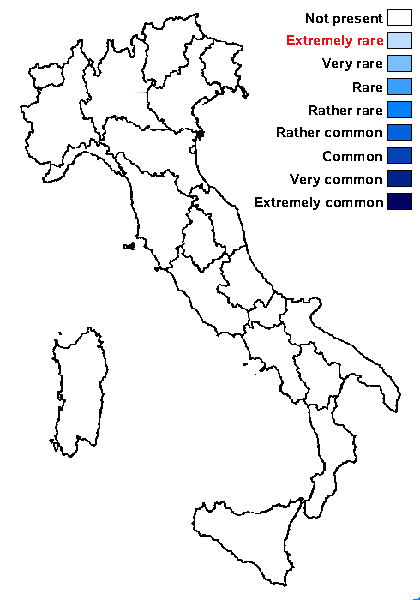Thelenella vezdae (H. Mayrhofer & Poelt) Coppins & Fryday
in Fryday & Coppins, Lichenologist, 36: 91, 2004. Basionym: Chromatochlamys vezdae H. Mayrhofer & Poelt - Herzogia, 7, 1-2: 39, 1985
Synonyms:
Distribution:
Description: Thallus crustose thinly episubstratic, continuous and film-like, whitish to pale brown, without a distinct prothallus. Perithecia globose, 0.2-0.4 mm across, dirty white to greenish, scattered, subsessile or half-immersed. Exciple colourless, of elongated hyphae; paraphysoids thread-like, 0.7-1 μm thick, persistent, branched and anastomosing; periphyses absent; hymenial gel I-, K/I-. Asci 8-spored, cylindrical-clavate, fissitunicate, with two functional wall-layers, the inner wall thin and the outer thick, with an ocular chamber. Ascospores 7-8-transversely septate to submuriform (with 1 longitudinal septum), hyaline, elongate to narrowly ellipsoid, 22-30 x 7-10 μm, the outer wall hardly thicker than the septa. Photobiont chlorococcoid, the algal cells without a gelatinous sheath. Spot tests: K-, C-, KC-, P-, UV-. Chemistry: without lichen substances.Note: an easily overlooked species, whose generic placement is uncertain. It grows on soft decaying wood, occasionally spreading to lignicolous bryophytes in various forest types, with optimum at low to mid-elevations; so far known from Central Europe only, most records being from the Alps, where it was reported from a few scattered localities outside the Italian territory. To be looked for in Italy.
Growth form: Crustose
Substrata: lignum
Photobiont: green algae other than Trentepohlia
Reproductive strategy: mainly sexual

Predictive model
Growth form: Crustose
Substrata: lignum
Photobiont: green algae other than Trentepohlia
Reproductive strategy: mainly sexual

Predictive model
 INDEX FUNGORUM
INDEX FUNGORUM
 GBIF
GBIF

